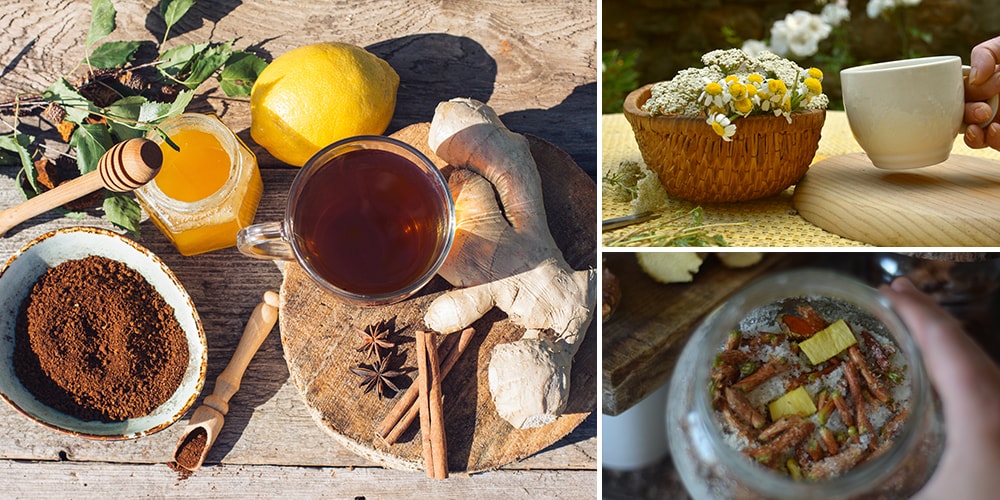
The Natural Pain Management Protocol You Need
If you’ve ever taken pain medicine, I suggest you read this article as I will show you the best way I’ve found to calm pain naturally.
Taking medicine has become part of our daily lives, just like brushing our teeth or washing our faces. This is why our bodies get used to it and the drugs don’t have the same effect anymore.
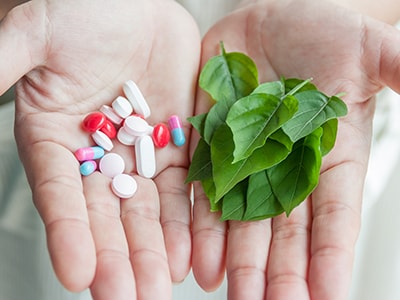
Switching to a natural pain management protocol is not only healthy for your body but gets rid of side effects and possible addiction.
I followed a pain management protocol from The Holistic Guide to Wellness: Herbal Protocols for Common Ailments and I decided to share my experience with you.
I had been fighting nagging lower back pain for a few months, and after a doctor’s checkup revealed there was nothing to worry about, I started taking nonsteroidal anti-inflammatory drugs (NSAIDs) to alleviate the pain.
I’m sure there’s been a time in your life when you were in pain and had to rely on this type of drugs to cope with it. Maybe you also went the extra mile and researched the side effects these drugs have when taken long-term. And just like me, you were probably terrified!
Luckily, there is a better way—a natural way that I found here.
In this comprehensive book, you’ll find 45 protocols for different health conditions. Here is the full list.
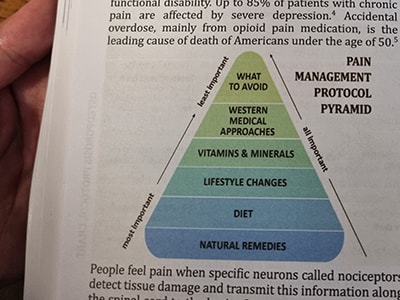 What you’ll notice in each protocol is that it starts with a layered pyramid. The pyramids prioritize the importance of things you need to do. The lower the level, the more impact it will have on your recovery.
What you’ll notice in each protocol is that it starts with a layered pyramid. The pyramids prioritize the importance of things you need to do. The lower the level, the more impact it will have on your recovery.
Then you’ll discover different treatments or remedies for each layer. The book is extremely practical; you can just open it and start following it.
At the end of each protocol, you’ll find a weekly chart. This chart will give you a sample plan that includes the interventions discussed in the chapter.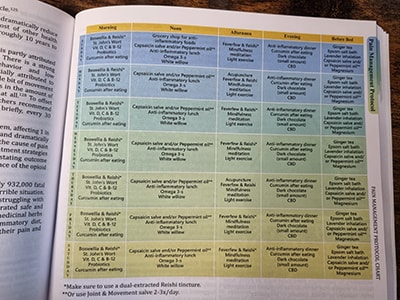
It also shows you a way to include them in a plan of action for the week, addressing that specific health concern.
I decided to start following the pain management protocol after reading this chapter and focused first on the lowest three pillars of the pyramid: natural remedies, diet, and lifestyle changes.
Natural Remedies
Peppermint Oil (Mentha piperita): Topical use of peppermint oil is effective in treating pain. Research has shown peppermint oil to be effective in treating a number of conditions, including neuralgia, headaches, and arthritis.
My way of including this oil in my routine was to combine it with fractionated coconut oil and lightly massage my back four days a week.
NOTE: Due to their high concentration, essential oils should always be diluted before topical use.
Inhalation of Lavender (Lavandula angustifolia): Lavender is well known for its calming, anti-inflammatory, and antioxidant effects. Studies have shown that inhalation of lavender oil can relieve pain.
So, I bought an air diffuser and essential lavender oil, which I used daily for a couple of hours in my bedroom.
The smell was amazing, so it was easy and pleasant to include this ritual into my daily life.
Diet
One of the suggestions in the book was to adopt an anti-inflammatory diet. The consumption of anti-inflammatory foods is associated with a decreased risk of dementia, rheumatoid arthritis and other autoimmune disorders, heart disease, cancer, diabetes, and nonalcoholic fatty liver disease. Additionally, an anti-inflammatory diet is linked to a longer lifespan.
Foods that are considered anti-inflammatory include foods that are high in antioxidants. These antioxidants neutralize the free radicals in the body that cause mutations that lead to cell damage.
Here are some of the foods I included in my daily meals: vegetables (kale, Brussels sprouts, bell peppers, broccoli, cabbage, wild greens, etc.), fruits (berries, grapes, cherries), healthy fats (avocado, nuts, salmon, sardines, olives, olive oil, avocado oil), spices (turmeric, cinnamon, oregano, etc.), green tea, and dark chocolate.
Lifestyle Changes
For the third pillar of the pyramid, the book suggests a good number of ways to change and improve your lifestyle. I decided to include just two as it was easier to fit them into my busy schedule:
Epsom Salt Bath (magnesium sulfate): Bathing activates the parasympathetic nervous system, a part of the body responsible for relaxation. According to experts, it can reduce inflammation and water retention and increase metabolism. So twice a week, I enjoy a warm bath after a long day at work.
Sleep: The link between sleep and pain is well documented. When you are asleep, the body repairs cells, restores energy, and releases important hormones and proteins. Poor sleep not only affects general health but has a direct impact on inflammation, pain response, and emotional well-being.
That’s why I went to bed two hours earlier every night, increasing my total amount of sleep from six to eight hours per night.
After just four weeks of following this simple protocol, I noticed significant benefits. The pain in my back started to fade away, and I’m fairly confident it will disappear soon.
You can check out more about The Holistic Guide to Wellness here.

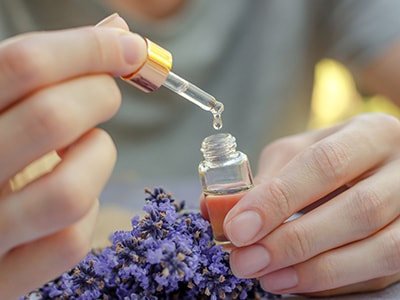
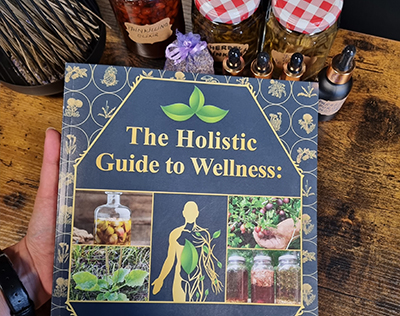
Hello,
I bought your book a while ago and I save most of the daily emails you send. But I am told by the people who work with my kidney transplant that I cannot use herbs or supplements due to the transplant. It was a perfect kidney from a 7 month old baby. So I am so scared of damaging it. I would like to hear your opinion on this.
I’m now curioUs too…I’m a type one brittle diabetic and need a pancreas transplant my kidneys ‘knock on wood’ are still ok surprisingly but having tried and in practice of herbs for 30 years I have not found peppermint to be of much help though it really depends on your pain and why you’re having it. Nerve pain can be combated against with cayenne pepper creams. Myself they also didn’t work however and be careful with allergies! I am allergic to dang near everything including nsaids so made my own natural remedy and had a reaction to that! Talk about frustrating…I have to even becareful of not eating over ripe fruits and vegetables due to histamine allergy! Anyways I hope someone can answer your question. Remedies are good for more minor things and few complex issues so be careful.
Herbs are part of your everyday life. Please ask more questions especially if there’s medication you are prescribed which can also damage other parts of the body. Congrats on your kidney but pls ask more questions
I am an amputee. I had a horrible surgeon who messed with my stump after the amputation. Anyway, I had to have it redone three years later because I had a bone spur and it was discovered than the surgeon had did it all wrong.
I am ready to get off the opioids I am on. (Also about 10 other perscriptions.)
I am greatly encourage to be learning all this info. A bit overwhelmed at the moment. Not sure where to start and how to proceed. I really need to find a doctor who can get me changed over. I am so tired of just being so exhausted all the time. I lost my life 5 years ago. My life right now is sleeping a lot. I am even on medication to help me stay awake. Which helps a little, but not enough. Plus, I just feel terrible half the time and I can’t tell why.
Any suggestions where to look for help with severe radiation damage. I was given the wrong Radiation treatments for the cancer I had. If it was not for YHWH causing a unexplainable mistake with first dose of the Chemo treatment I got. I was only given 1/4 the dose I was to have. The radiation would have killed me within ten treatments. Like it did to a lady who came a few months later. Same cancer, same mistake with the radiation treatments, however she got the full first dose of the Chemo.
I ended up surviving because of the mistake with the Chemo. I was burnt so badly that I had skin burnt off in my whole groin area twice. After which I took breaks in radiation treatments of a few weeks. In all I had 37 radiation treatments and 3 1/4 doses of the Chemo.
The doctors I am seeing finally have looked close enough to see the damage that is being done. But, it is so rare that none of them has any idea how to treat it.
It really has been a long painful journey for 23 years. YHWH has me here for a reason.(?) So, if anyone can help me figure all this out. I appreciate suggestions of how to get organized and where to look for YHWH’S healing herbs and plants. Because, it isn’t with man made drugs at all. After all man made radiation treatments actually did this to me. I must of been really stupid not to look for YHWH’S natural ways of helping me recover. Who knows it might have saved my left leg.
Thank you for reading my comments. I look forward to any advise (none medical, remember) and or suggestions.
Joe Fawcett